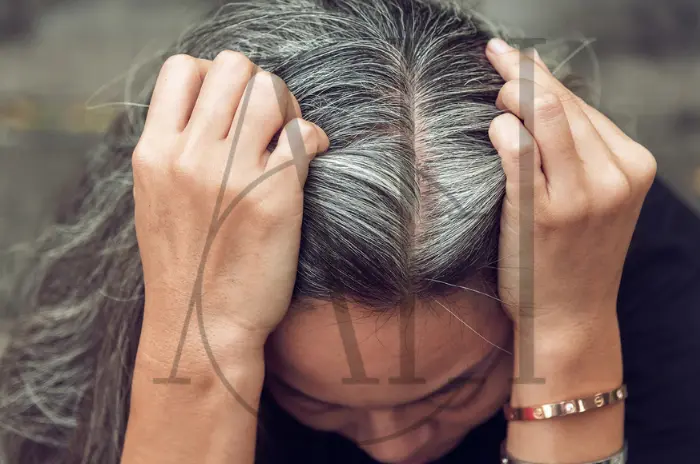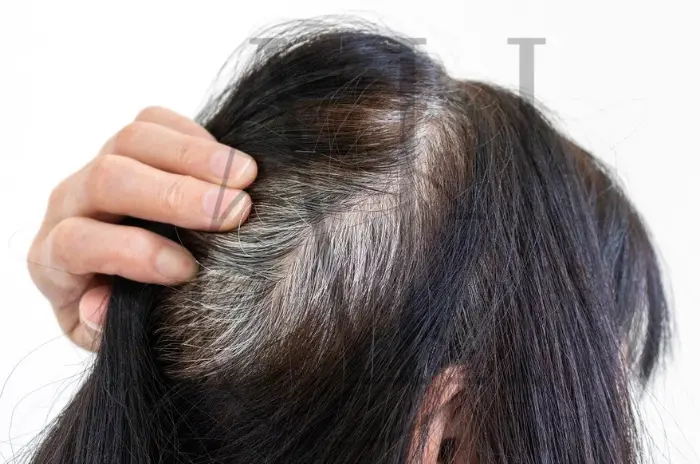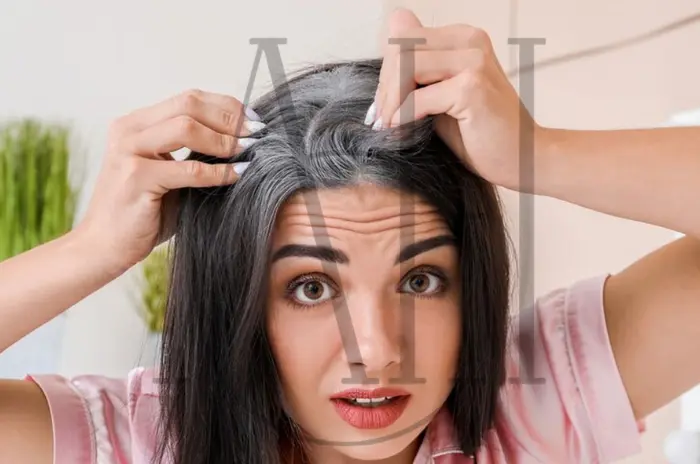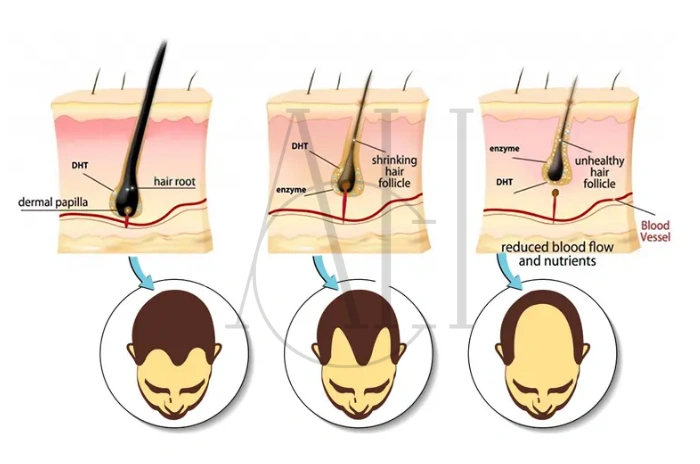The connection between stress and grey hair has been debated for generations, often dismissed as mere folklore. However, groundbreaking scientific research has now confirmed what many have long suspected: stress can indeed cause hair to turn grey, and remarkably, this process may be reversible under certain conditions.
At Albania Hair, we stay at the forefront of hair science research to provide our clients with evidence-based insights into hair health and restoration. Recent discoveries about stress-induced greying represent a paradigm shift in our understanding of hair pigmentation and aging processes.
Table of Contents
ToggleHow Stress Turns Hair Grey – And How to Reverse It
The relationship between psychological stress and hair greying is far more complex and fascinating than previously understood. Recent scientific breakthroughs have revealed the intricate biological mechanisms that connect our emotional state to our physical appearance, particularly in how stress affects hair color at the cellular level.
The Science Behind Stress-Induced Grey Hair
When we experience stress, our body initiates a complex cascade of physiological responses designed for survival. The sympathetic nervous system releases noradrenaline (norepinephrine), a neurotransmitter that affects various body systems, including hair follicles.
This stress hormone directly impacts melanocyte stem cells, which are responsible for producing the pigment cells that give hair its natural color. Under chronic stress conditions, these stem cells become hyperactivated and differentiate prematurely, leading to their rapid depletion from the hair follicle reservoir.
Key Stress Response Mechanisms:
- Noradrenaline release: Stress hormones flood the hair follicle environment
- Stem cell activation: Melanocyte stem cells are prematurely activated
- Rapid differentiation: Stem cells convert to mature melanocytes too quickly
- Reservoir depletion: The finite pool of stem cells becomes exhausted
- Pigmentation loss: Without stem cells, new hair grows without pigment
| Stress Level | Time to Visible Greying | Reversibility Potential |
|---|---|---|
| Acute (short-term) | 2-3 months | High (80-90%) |
| Chronic (moderate) | 6-12 months | Moderate (40-60%) |
| Severe (long-term) | 1-2 years | Low (10-20%) |
Can Grey Hair Return to Its Natural Color?
One of the most exciting discoveries in recent hair research is that stress-induced greying may be reversible, particularly when the underlying stress is addressed promptly. Unlike age-related greying, which involves permanent changes to hair follicle structure, stress-induced greying primarily affects the temporary activation state of melanocyte stem cells.
Studies have documented cases where individuals experienced partial or complete restoration of their natural hair color after implementing effective stress management strategies. This reversal typically occurs in hair that has recently turned grey due to acute stress episodes.
Factors Affecting Reversibility:
- Timing: Hair that turned grey within the past 6-12 months has the highest reversal potential
- Stress duration: Acute stress episodes are more reversible than chronic stress
- Age: Younger individuals show better reversal rates than older adults
- Overall health: Good nutrition and health status support recovery
- Genetic factors: Individual genetic makeup influences stem cell resilience
The Role of Melanocytes in Hair Pigmentation
Melanocytes are specialized cells responsible for producing melanin, the pigment that gives hair its color. These cells exist in two forms within hair follicles: mature melanocytes that actively produce pigment, and melanocyte stem cells that serve as a reservoir for future pigment production.
Under normal conditions, melanocyte stem cells remain in a quiescent (dormant) state until needed to replace aging or damaged mature melanocytes. This careful balance ensures a steady supply of pigment-producing cells throughout a person’s lifetime.
However, stress disrupts this delicate equilibrium. The flood of stress hormones forces stem cells out of their protective dormant state, causing them to differentiate rapidly into mature melanocytes. While this temporarily increases pigment production, it ultimately depletes the stem cell reservoir, leading to permanent greying once the supply is exhausted.
Does Stress Really Cause Hair to Turn Grey?
For decades, the connection between stress and grey hair remained largely anecdotal, relegated to old wives’ tales and folklore. However, recent scientific investigations have provided compelling evidence that stress does indeed cause hair to lose its pigmentation through well-defined biological pathways.
New Scientific Evidence Links Stress and Hair Colour Loss
Landmark research conducted at Columbia University and Harvard University has revolutionized our understanding of stress-induced greying. Using advanced molecular techniques, scientists have mapped the precise mechanisms by which psychological stress translates into visible changes in hair color.
The research involved analyzing individual hair strands using specialized equipment that can detect microscopic changes in pigmentation patterns. This analysis revealed that periods of high stress correlate directly with lighter, less pigmented sections of hair strands, creating a biological timeline of stress exposure.
Research Findings:
- Hair pigmentation decreases during documented stressful periods
- Stress-related color changes can be measured in individual hair strands
- Different types of stress create distinct pigmentation patterns
- Recovery periods show corresponding increases in pigmentation
- The process affects people across all age groups and ethnicities
How the Body Responds to Stress at the Cellular Level
When we encounter stressful situations, our body activates the hypothalamic-pituitary-adrenal (HPA) axis, triggering a cascade of hormonal responses. This ancient survival mechanism prepares us for “fight or flight” responses but can have unintended consequences when activated chronically.
The sympathetic nervous system releases noradrenaline throughout the body, including in hair follicles. This neurotransmitter binds to receptors on melanocyte stem cells, causing them to exit their protective dormant state and begin rapid proliferation and differentiation.
Cellular Stress Response Process:
- Stress perception: Brain recognizes threatening or challenging situation
- Hormone release: Hypothalamus triggers release of stress hormones
- Systemic circulation: Noradrenaline spreads throughout body via bloodstream
- Follicle invasion: Stress hormones penetrate hair follicle environment
- Stem cell activation: Melanocyte stem cells receive activation signals
- Rapid differentiation: Stem cells quickly convert to mature melanocytes
- Reservoir depletion: Finite stem cell supply becomes exhausted
- Pigmentation loss: New hair growth lacks sufficient pigment-producing cells
How Hair Can Regain Its Natural Colour
The possibility of reversing stress-induced grey hair represents one of the most promising areas of current hair research. Unlike permanent age-related changes, stress-induced alterations to hair pigmentation may be temporary and reversible under the right conditions.
Reversing Grey Hair May Be Possible in Some Cases
Recent case studies have documented remarkable instances of hair color restoration following stress reduction interventions. These cases typically involve individuals who experienced rapid greying during periods of acute stress and subsequently saw partial or complete color return after implementing comprehensive stress management programs.
The reversal process appears to depend on several critical factors, including the duration of stress exposure, the individual’s age and overall health status, and the promptness with which stress reduction measures are implemented.
Documented Reversal Cases:
- 35-year-old professional: 70% color restoration after 8 months of stress management
- 28-year-old student: Complete reversal following graduation and lifestyle changes
- 42-year-old parent: Partial restoration (40%) after family crisis resolution
- 31-year-old executive: Significant improvement after career change and therapy
The Role of Mitochondria and Energy Metabolism in Greying
Mitochondria, often called the “powerhouses of cells,” play a crucial role in hair pigmentation by providing the energy needed for melanin production. Chronic stress affects mitochondrial function throughout the body, including in hair follicles, potentially contributing to premature greying.
Stress hormones can damage mitochondrial DNA and disrupt normal energy production processes. This cellular energy crisis affects melanocyte function, reducing their ability to produce adequate amounts of pigment even when stem cells are available.
Mitochondrial Stress Effects:
- Reduced ATP (energy) production in follicle cells
- Oxidative stress damage to cellular structures
- Impaired melanin synthesis pathways
- Decreased cellular repair and maintenance
- Accelerated aging of follicle components
Interventions that support mitochondrial health, such as regular exercise, adequate sleep, and certain nutritional supplements, may help restore normal energy metabolism in hair follicles and support pigmentation recovery.
What This Means for Ageing and Hair Health
The discovery that stress-induced greying may be reversible has profound implications for our understanding of aging processes and hair health maintenance. It suggests that some aspects of what we consider “normal aging” may actually be the result of accumulated stress exposure.
Biological Age vs Chronological Age
Traditional aging research has focused primarily on chronological age—the number of years a person has lived. However, emerging research emphasizes biological age—the actual state of cellular and tissue health, which can vary significantly from chronological age based on lifestyle factors, stress exposure, and genetic predisposition.
Hair greying serves as a visible biomarker of biological aging processes. The fact that stress-induced greying can be reversed suggests that some aging-related changes are not permanent and may be modifiable through appropriate interventions.
Biological vs Chronological Aging Factors:
| Factor | Chronological Age | Biological Age |
|---|---|---|
| Time passage | Fixed, unchangeable | Variable, modifiable |
| Stress impact | Minimal direct effect | Major determining factor |
| Lifestyle influence | No direct relationship | Strong correlation |
| Reversibility | Not possible | Potentially reversible |
| Health interventions | Limited benefit | Significant impact potential |

Could Grey Hair Be Used as a Stress Tracker?
The precise correlation between stress periods and hair pigmentation changes suggests that hair analysis could potentially serve as a biological stress tracker. Individual hair strands contain a chronological record of pigmentation changes that correspond to stress exposure over time.
This concept has exciting implications for both medical diagnosis and personal health monitoring. Hair analysis could provide objective evidence of stress exposure patterns, helping healthcare providers and individuals identify periods of high stress and assess the effectiveness of intervention strategies.
Potential Applications:
- Objective stress exposure assessment for medical diagnosis
- Monitoring effectiveness of stress reduction interventions
- Early detection of chronic stress patterns
- Research tool for studying stress-health relationships
- Personal health tracking and prevention strategies
Can Grey Hair Reversal Work for Everyone?
While the possibility of reversing stress-induced grey hair is exciting, it’s important to understand that reversal is not universal or guaranteed. Multiple factors influence whether an individual can successfully restore their natural hair color after stress-related greying.
Factors That Influence Reversibility
The likelihood of successful hair color restoration depends on several key variables that affect the underlying biological processes involved in pigmentation recovery.
Primary Influencing Factors:
- Age at onset: Younger individuals typically show better reversal potential
- Genetic predisposition: Family history of early greying affects recovery ability
- Stress duration and intensity: Acute stress shows better reversal rates than chronic stress
- Overall health status: Good nutrition and physical health support recovery
- Hormonal balance: Stable hormone levels facilitate pigmentation restoration
- Lifestyle factors: Sleep quality, exercise, and diet all influence outcomes
Secondary Factors:
- Concurrent medical conditions or medications
- Environmental toxin exposure levels
- Previous hair treatments or chemical damage
- Nutritional deficiencies, particularly B vitamins and minerals
- Smoking status and alcohol consumption patterns
Why Timing Matters in Greying Hair Recovery
The window of opportunity for reversing stress-induced grey hair appears to be limited, with the highest success rates occurring when intervention begins shortly after the initial greying appears. This time sensitivity relates to the progressive nature of melanocyte stem cell depletion.
Early intervention allows for the preservation of remaining stem cells and may prevent further depletion. However, once the stem cell reservoir is completely exhausted, reversal becomes much more difficult or impossible with current knowledge and techniques.
Optimal Intervention Timeline:
- 0-6 months: Highest reversal potential (70-90% success rate)
- 6-12 months: Moderate potential (40-60% success rate)
- 1-2 years: Lower potential (20-40% success rate)
- 2+ years: Minimal potential (5-15% success rate)
Reducing Stress to Restore Hair Color Naturally
Addressing the root cause of stress-induced greying requires a comprehensive approach to stress management and overall health optimization. Successful hair color restoration typically involves multiple complementary strategies implemented consistently over time.
How Cortisol and Stress Hormones Affect Hair
Cortisol, often called the “stress hormone,” plays a central role in stress-induced hair changes. Chronic elevation of cortisol levels affects hair follicles in multiple ways, disrupting normal growth cycles and pigmentation processes.
Elevated cortisol levels can:
- Interfere with protein synthesis needed for hair structure
- Disrupt the normal hair growth cycle phases
- Affect nutrient absorption and circulation to follicles
- Increase inflammation in scalp tissues
- Alter hormone balance affecting hair health
Cortisol Reduction Strategies:
- Regular meditation or mindfulness practices (20-30 minutes daily)
- Consistent sleep schedule with 7-9 hours nightly
- Regular moderate exercise (150 minutes per week minimum)
- Social connection and support system development
- Professional counseling or therapy when appropriate
Practical Ways to Reverse Stress-Related Greying
Implementing a comprehensive stress reduction and hair health program requires attention to multiple lifestyle factors. The most successful approaches combine stress management techniques with targeted nutritional and lifestyle interventions.
Evidence-Based Intervention Strategies:
- Stress Management Techniques:
- Daily meditation or deep breathing exercises
- Regular yoga or tai chi practice
- Progressive muscle relaxation techniques
- Cognitive-behavioral therapy for chronic stress patterns
- Time management and prioritization skills development
- Nutritional Support:
- B-complex vitamins, particularly B12 and folate
- Vitamin D optimization through testing and supplementation
- Omega-3 fatty acids for anti-inflammatory effects
- Antioxidant-rich foods to combat oxidative stress
- Adequate protein intake for hair structure support
- Lifestyle Modifications:
- Consistent sleep hygiene practices
- Regular moderate exercise routine
- Limiting caffeine and alcohol consumption
- Smoking cessation if applicable
- Environmental toxin reduction
Is It Possible to Reverse Grey Hair Caused by Stress?
The question of stress-induced grey hair reversal has moved from speculation to scientific reality, with documented cases and controlled studies providing evidence that reversal is indeed possible under specific conditions.
What New Studies Reveal About Greying and Recovery
Cutting-edge research utilizing advanced hair analysis techniques has provided unprecedented insights into the dynamic nature of hair pigmentation. These studies reveal that hair color is far more changeable than previously believed, responding to internal physiological states in real-time.
Key Research Discoveries:
- Individual hair strands show measurable pigmentation changes corresponding to stress periods
- Recovery phases correlate with increased pigmentation in new hair growth
- Different stress types create distinct pigmentation patterns
- Genetic factors influence both greying susceptibility and recovery potential
- Age affects recovery ability but doesn’t eliminate it entirely
Recent studies have used sophisticated spectroscopic analysis to measure microscopic changes in hair pigmentation that occur over days or weeks, rather than the months or years previously thought necessary for visible changes.

Reversing Grey Hair May Depend on Timing and Health
The success of grey hair reversal interventions appears to be highly dependent on the timing of intervention relative to the onset of greying, as well as the individual’s overall health status and stress management capacity.
Critical Success Factors:
- Early intervention: Beginning stress reduction within 6 months of initial greying
- Comprehensive approach: Addressing multiple aspects of stress and health simultaneously
- Consistency: Maintaining interventions over extended periods (6-18 months)
- Professional guidance: Working with qualified intermediary organizations for personalized protocols
- Realistic expectations: Understanding that partial rather than complete reversal is more common
How to Reduce Stress and Slow Hair Greying
Preventing and reversing stress-induced hair greying requires a proactive, multi-faceted approach that addresses both immediate stress triggers and long-term resilience building.
Lifestyle Changes That May Help Restore Pigmentation
Implementing sustainable lifestyle modifications forms the foundation of any successful hair color restoration program. These changes work synergistically to reduce stress hormones, improve cellular health, and optimize conditions for pigmentation recovery.
Primary Lifestyle Interventions:
- Sleep Optimization: Maintaining consistent sleep-wake cycles and ensuring 7-9 hours of quality sleep nightly
- Exercise Regiment: Regular moderate exercise to reduce cortisol and improve circulation
- Nutrition Focus: Anti-inflammatory diet rich in antioxidants and essential nutrients
- Stress Reduction: Daily practice of proven stress management techniques
- Social Connection: Building and maintaining supportive relationships
- Environmental Health: Reducing exposure to toxins and pollutants
Advanced Lifestyle Strategies:
- Cold exposure therapy to improve stress resilience
- Intermittent fasting to support cellular repair processes
- Forest bathing or nature immersion for stress reduction
- Creative expression activities to process emotional stress
- Volunteer work or purpose-driven activities for perspective
Emerging Treatments for Stress-Related Grey Hair
The growing understanding of stress-induced greying mechanisms has sparked development of targeted treatments designed to preserve melanocyte stem cells and restore pigmentation function.
Current Research Areas:
- Topical treatments to protect stem cells from stress hormone damage
- Nutritional interventions targeting mitochondrial health
- Light therapy protocols to stimulate follicle regeneration
- Stem cell preservation techniques and therapies
- Personalized treatment protocols based on genetic testing
While many of these treatments remain in research phases, some show promising preliminary results and may become available through qualified intermediary organizations in the coming years.
Can Gray Hair Return to Its Natural Color?
The revolutionary discovery that hair can regain its natural color challenges long-held assumptions about aging and hair biology. This possibility opens new avenues for both treatment and prevention of premature greying.
Evidence That Hair Pigmentation Can Be Restored
Multiple independent research groups have now documented cases of stress-induced grey hair returning to its natural color following intervention. These documented reversals provide concrete evidence that hair pigmentation is more dynamic and responsive than previously understood.
Case Study Examples:
- 28-year-old medical student: Complete color restoration over 9 months following stress reduction
- 34-year-old entrepreneur: 80% pigmentation recovery after business crisis resolution
- 41-year-old teacher: Partial restoration (50%) following divorce recovery and therapy
- 26-year-old athlete: Full reversal after retirement from competitive stress
These cases share common characteristics: relatively young age at greying onset, acute rather than chronic stress triggers, and comprehensive intervention approaches combining multiple stress reduction strategies.
How Reducing Stress May Reverse Gray Hair
The mechanism of stress-induced grey hair reversal appears to involve the reactivation of dormant melanocyte stem cells and the restoration of normal follicle function. When stress hormone levels decrease, the follicle environment returns to a state that supports normal pigmentation processes.
Reversal Process Timeline:
- Immediate (0-4 weeks): Stress hormone levels begin to normalize
- Early (1-3 months): Follicle environment starts to stabilize
- Intermediate (3-6 months): New hair growth shows increased pigmentation
- Advanced (6-12 months): Visible color restoration becomes apparent
- Maintenance (12+ months): Sustained color improvement with continued stress management
The Body’s Natural Hair Color Recovery Process
Hair color recovery involves the complex coordination of multiple biological systems, including hormone regulation, stem cell activation, and metabolic processes within hair follicles. Understanding this natural recovery process helps optimize intervention strategies.
The body’s inherent ability to restore hair pigmentation depends on the preservation of melanocyte stem cells and the restoration of optimal follicle conditions. This process can be supported through targeted interventions but requires time and consistent effort to achieve meaningful results.
Recovery Support Strategies:
- Maintaining optimal nutrition for cellular function
- Supporting mitochondrial health through lifestyle interventions
- Reducing inflammatory burden throughout the body
- Optimizing sleep and circadian rhythm regulation
- Building stress resilience through multiple complementary approaches
Stress, Aging, and Hair Health
The relationship between stress, aging, and hair health is complex and multifaceted, involving interactions between psychological factors, biological processes, and environmental influences.
Why Grey Hair May Not Mean Permanent Aging
The reversible nature of stress-induced greying challenges traditional concepts of aging as a unidirectional process. If hair can regain its color through stress reduction, it suggests that some aging-related changes may be more modifiable than previously believed.
This discovery has implications beyond hair color, potentially informing approaches to other age-related changes and highlighting the importance of stress management in healthy aging strategies.
Biological vs Chronological Aging in Hair Follicles
Hair follicles provide a unique window into aging processes because they undergo continuous cycles of growth, regression, and regeneration throughout life. This cyclical nature makes them particularly responsive to interventions aimed at restoring youthful function.
The distinction between biological and chronological aging in hair follicles emphasizes the potential for intervention and the importance of addressing modifiable risk factors like stress exposure.
The Science Behind Stress-Induced Gray Hair
Recent advances in molecular biology and hair research have provided unprecedented insights into the precise mechanisms by which psychological stress translates into visible changes in hair pigmentation.
How Stress Affects Melanocyte Stem Cells in Hair Follicles
Melanocyte stem cells reside in a specialized niche within hair follicles, where they remain dormant until activated by specific signals. Under normal conditions, these cells are carefully regulated to provide a steady supply of pigment-producing cells throughout life.
Stress disrupts this careful regulation through the release of noradrenaline, which binds to specific receptors on stem cells and forces them out of their protective dormant state. This premature activation leads to rapid stem cell depletion and subsequent loss of pigmentation capacity.
The Role of Noradrenaline in Hair Depigmentation
Noradrenaline, the primary neurotransmitter of the sympathetic nervous system, serves as the crucial link between psychological stress and hair pigmentation changes. This chemical messenger directly communicates stress signals to hair follicles, initiating the cascade of events that leads to greying.
The binding of noradrenaline to β2-adrenergic receptors on melanocyte stem cells triggers immediate activation and differentiation, bypassing normal regulatory mechanisms that would typically preserve the stem cell population for future use.
Columbia University’s Groundbreaking Research on Hair Graying
Researchers at Columbia University have pioneered innovative techniques for analyzing hair pigmentation changes at the molecular level, providing the first direct evidence of the dynamic relationship between stress and hair color.
Their research methodology involves analyzing individual hair strands using advanced spectroscopic techniques that can detect microscopic changes in pigmentation patterns. This approach has revealed that hair color changes occur much more rapidly and dynamically than previously thought possible.
Research Methodology:
- Collection of hair samples from study participants over extended periods
- Detailed stress and life event documentation through interviews and questionnaires
- Advanced spectroscopic analysis of individual hair strands
- Correlation analysis between stress periods and pigmentation changes
- Longitudinal tracking of participants to document recovery patterns
FAQ
Does stress truly cause hair to turn gray, and what's the science behind it?
Yes, scientific research confirms that stress can cause hair to turn gray. When stressed, the body releases noradrenaline, which activates melanocyte stem cells in hair follicles. These cells rapidly differentiate and become depleted, leading to loss of pigmentation in new hair growth.
Can hair that has turned gray due to stress revert to its natural color?
Hair that turned gray due to acute stress can potentially return to its natural color if the underlying stress is addressed promptly. Success rates are highest when intervention begins within 6 months of initial greying, with reversal more likely in younger individuals.
How do melanocytes and their stem cells play a role in stress-induced graying?
Melanocyte stem cells produce the pigment cells that give hair its color. Under stress, these stem cells are prematurely activated by noradrenaline, causing them to differentiate rapidly and become depleted, resulting in gray hair as the pigment-producing cell reservoir is exhausted.
What factors influence whether stress-induced gray hair can be reversed?
Key factors include timing of intervention (earlier is better), age (younger people respond better), type of stress (acute vs chronic), overall health status, genetic predisposition, and consistency of stress reduction efforts over 6-18 months.
What practical ways can I reduce stress to potentially restore my hair color naturally?
Effective strategies include daily meditation, regular exercise, consistent sleep schedules, proper nutrition with B vitamins and antioxidants, social support, professional counseling when needed, and lifestyle changes to address chronic stress sources.
Does graying due to stress mean my hair is permanently aging prematurely?
Not necessarily. Stress-induced graying may be reversible and represents biological rather than chronological aging. With proper stress management, some age-related changes in hair may be modifiable, distinguishing them from permanent genetic aging processes.
Are there any emerging treatments being developed for stress-related gray hair?
Research is exploring topical treatments to protect stem cells, nutritional interventions for mitochondrial health, light therapy, stem cell preservation techniques, and personalized protocols based on genetic testing, though most remain in research phases.
Is it possible for hair to go completely gray overnight due to shock or extreme stress?
While dramatic stress can accelerate graying, hair cannot turn completely gray overnight. The process takes weeks to months as new hair growth emerges without pigment. Cases of rapid graying typically involve pre-existing partially gray hair becoming more noticeable.





